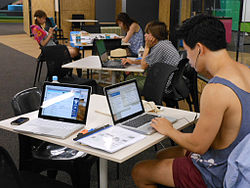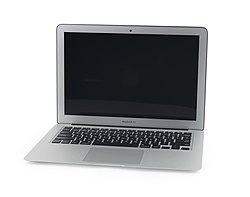Laptop
A laptop is a computer which is easy to carry around. A modern laptop is self-contained, with a screen, keyboard, and pointing device (like a touchpad or pointing stick), plus usually, speakers, a microphone and a camera (webcam). This is all powered by a built-in rechargeable battery, however, the user can also plug the laptop in to use it while recharging the battery. Also, most other external devices such as a monitor and keyboard can be attached if required. The laptop screen folds down over the keyboard, along a hinge, for carrying.
Laptops have advantages over desktop computers, such as:
- They can be carried almost anywhere, such as between home and office or school.
- They usually have a built-in webcam, microphone and speakers, making video calls much easier.
- They can be used in smaller spaces.
- They can easily be locked away securely, making them harder to steal.
Disadvantages of laptops include:
- They're normally more expensive.
- They usually have low technical specifications.
- They're often slower than desktop computers with complex tasks like gaming, video editing or graphic design.[1]
- They're easily stolen.
- They travel frequently, so laptops are more likely to be damaged.
- They're more difficult and expensive to repair.
History
Like computers themselves, portable microcomputers were not invented at any one time by one person. They developed gradually.
The Portal, from the French company R2E Micral CCMC, appeared in September 1980 at the SICOB show in Paris. Its keyboard had 58 alphanumeric keys and 11 numeric keys (separate blocks), a 32-character LED screen, a floppy disk drive, a printer and a 220V power supply. It weighed 12 kg (26 pounds) and its dimensions were 45 cm × 45 cm × 15 cm (18 in x 18 in x 6 in). It had no hinge and its operating system was Prolog.[2]
Some historians, however, count as the first "true" portable to be the Osborne 1. It was created in 1981 by Adam Osborne, who was also a former book publisher. He was the founder of Osborne Computer. His portable computer weighed 11 kg (24 pounds) and had a five-inch (13 cm) screen, a serial port and two floppy disk drives. Several programs were included with the Osborne 1. Customers could also buy a 1-hour battery pack.
The first "laptop-sized notebook computer" was the Epson HX-20, released in July 1982.[3][4] It had a four-line, liquid crystal display (LCD) screen, a rechargeable battery, and a receipt-size printer, in a 1.6 kg (3.5 lb) body, the size of an A4 notebook.[5] It was described as a "laptop" and "notebook" computer in its patent.[5]
The first computer to use the "clamshell" design, which is used in almost all modern laptop designs, was the GRiD Systems Corporation's GriD Compass, released in April 1982. This computer was one fifth the weight of any other computer used at that time, however, it required mains power, because it had no battery. Despite this, they were very popular with the Military of the United States and NASA, who used the laptop in its Space Shuttle program, in the 1980s.
Also in 1982, two computer designers from Microsoft, Kazuhiko Nishi and Bill Gates, worked on a new portable computer. The prototype was presented to Radio Shack, who agreed to start making it. It was launched in 1983, as the TRS-80 Model 100, which had an eight-line LCD screen. In 1986, the improved version, called TRS Model 200, was released, which had a much larger, fold-down LCD screen, and looked pretty much like the laptops that we know today.
The next few years saw the appearance of a laptop PC from Compaq Computers and the first notebook-style laptop from NEC called NEC UltraLite. The year 1989 was quite successful for laptop producers. First, Apple Computer developed the Macintosh Portable, the evolution of which turned it into the PowerBook. Then, a company named Zenith Data Systems introduced the Zenith MinisPort, a portable computer weighing 6 pounds (2.72 kg). Finally, there was Compaq Computers, who released the Compaq LTE.
The development of laptops is continuing, with various upgrades and additional functions added, including screens with new screen technologies like in-plane switching panels and touch screens, all while the devices continue to get smaller and lighter, and more powerful. Around 2007, netbook computers became popular. Netbooks are small, cheap laptops with screens of about 10 inches (25 cm) or less, but replaced the usual Hard disk at the time with a solid-state drive (SSD). Now, SSDs are more common in laptops, and netbooks are no longer made. Despite these advances, after 2010, people bought fewer laptops because of the popularity of tablet computers, which are even more portable.[6] Today, laptops continue to be used for areas like education, video editing and gaming.
In 2005, an organization called One Laptop Per Child started trying to improve education for students in less rich countries using their own laptop, the XO-1. However, their plan failed, and OLPC now hands out Chromebooks instead. [7]
Gaming laptop
A gaming laptop is a laptop that is built to play video games. Gaming laptops are more powerful than regular laptops, and are made with stronger parts, a separate graphic card (GPU), large and bright screens with fast frame rates, colorful keyboards that light up, and more fans and vents. However, they are more expensive than regular laptops. The most common program people use to play games on these laptops is Steam.

Laptop Media
A variety of laptops. Clockwise from top left: A 2021 MacBook Pro by Apple Inc.; a 2019 Microsoft Surface Pro 7 with detachable hinge (left) and a 2018 Dell XPS 15 9570 with 360 degree hinge (right); a 2014 ThinkPad Helix by Lenovo with detachable screen; and a 2014 Acer Chromebook 11
The Epson HX-20, the first "notebook computer", was invented in 1980 and introduced in 1982.
GRiD Compass 1101 (1982)
A Zenith SupersPort laptop, released in 1988
Compaq Armada laptop from the late 1990s
Apple MacBook Air, an "ultraportable" laptop weighing under 3.0 lb (1.36 kg)
A Lenovo IdeaPad laptop
References
- ↑ "Laptop Runner". laptoprunner.com. 4 April 2015. Archived from the original on 15 December 2015. Retrieved 16 December 2015.
- ↑ "OLD-COMPUTERS.COM : The Museum". www.old-computers.com. Archived from the original on December 25, 2001. Retrieved 2017-07-12.
- ↑ Peres, Michael, ed. (2013-05-29). The Focal Encyclopedia of Photography. doi:10.4324/9780080477848. ISBN 9780080477848.
- ↑ Potekhina, L.I. (2020-12-31). "Museum of the Decembrists in Chita". Historical Courier (6): 183–190. doi:10.31518/2618-9100-2020-6-12. ISSN 2618-9100. S2CID 234382431.
- ↑ 5.0 5.1 Weik, Martin H. (2000). "Portable operating system interface for computer environments". Computer Science and Communications Dictionary. p. 1301. doi:10.1007/1-4020-0613-6_14313. ISBN 978-0-7923-8425-0.
- ↑ PC sales decline PC World
- ↑ "OLPC – More than a laptop". Retrieved 2025-01-29.
Other websites
| Wikimedia Commons has media related to Lua error in Module:Commons_link at line 62: attempt to index field 'wikibase' (a nil value).. |














